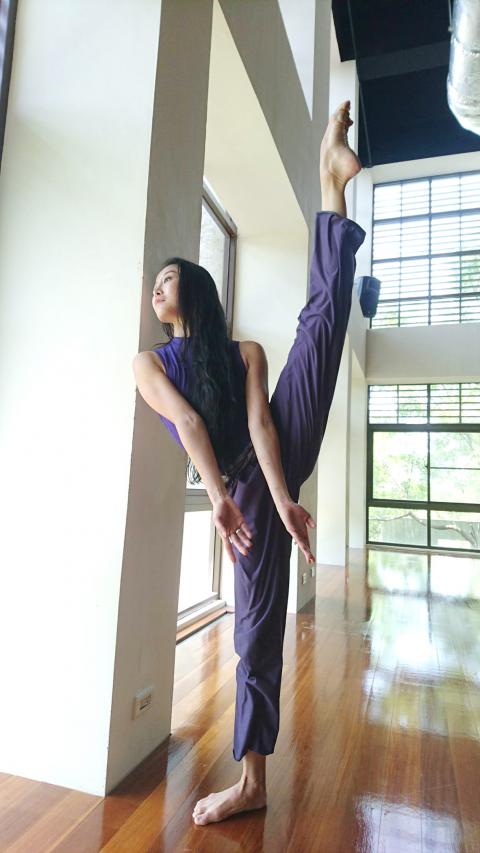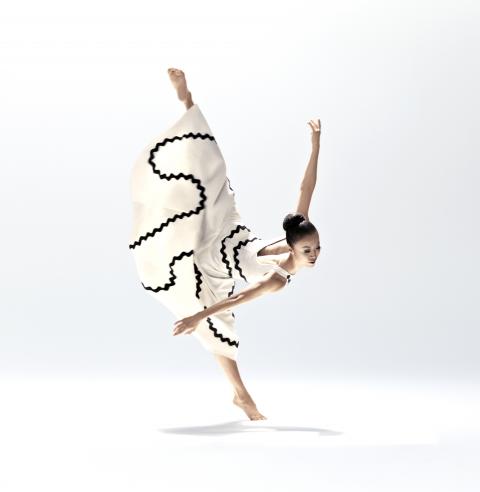The eyes of the nation will be on the Taipei Municipal Stadium tonight as the opening ceremony of the 2017 Taipei Summer Universiade gets under way at 6pm, including friends and family of the hundreds of Taiwanese dancers, university students and high-school students who will be performing.
Given one of the themes of the local and international advertising that Taipei has been running for the Games is “Taipei in Motion,” it should come as no surprise that dancers were given a key role in the welcoming event. If there is one thing that dancers know even more about than athletes, it is motion.
Wang Yun-yu (王雲幼), dean of Taipei National University of the Arts (TNUA) School of Dance, was asked to be the chief production director for the Games.

Photo courtesy of Zhang Xiao-xiong
Asked how long it took to pull the show together, Wang laughed and said the process began in January last year, when the storyline was finalized and she could start to invite choreographers, schools and dancers.
Three directors were chosen for the three cultural program segments of the ceremony: Anarchy Dance Theatre founder Jeff Hsieh (謝杰樺), theater director Liao Ruo-han (廖若涵) and visual artist Lin Kun-ying (林昆穎).
Wang said she wanted young, mid-career professionals as choreographers and designers because she wanted to promote youth, and she also wanted to highlight the nation’s wealth of professional dancers, as well as its dance students.

Photo courtesy of Hibbard Nash
About 100 modern dancers and more than 900 dance students are taking part in the ceremony, Wang said.
National Taiwan University of Sport, the National Taiwan College of Performing Arts, TNUA, Hwa Kang Arts School, the Aboriginal divisions and dance divisions at five municipal senior-high schools and four junior-high schools in New Taipei City and Taipei are contributing performers.
Many of the choreographers have their own companies, which meant they had to set aside their own work to help — such as Horse cofounder Su Wei-chia (蘇威嘉); Formosa Aboriginal Song and Dance Troupe director Fangas Nayaw; and Benson Tsai (蔡博丞) of B.DANCE.
Others are freelancers, such as Tung I-fen (董怡芬) and Shen Yi-wen.
Wang also wanted to get Taiwanese expatriates involved, so she recruited Martha Graham Dance Company principal dancer Chien Pei-ju (簡珮如) and Billy Chang Yi-chun (張逸軍), a former soloist with Cirque du Soleil, to perform, and Lin Li-chuan (林立川), who danced with the Atlanta Ballet and other companies, to choreograph.
Some of the choreographers started going to the schools in February to work with the students, but the real training began in April, Wang said.
In the past two weeks everything moved into high gear, with rehearsals at TNUA, the small stadium next to the Taipei Municipal Stadium and at buildings at Taipei International Airport (Songshan airport).
The entire cast and production had their first full dress rehearsal on Tuesday night and a second one on Thursday night.
The performers feel they are “performing for the entire nation, to show that Taiwan is not so small a place,” Wang said.
For Chien, the invitation from Wang to join the cast was a welcome chance to come home to perform.
“I didn’t think much about it, just said yes,” she said in a telephone interview yesterday. “It was a dream come true. Living in New York for 10 years, I have wanted to come back to perform and had been planning to come for the last three years, but things didn’t work out before.”
She arrived back in Taipei about two-and-a-half weeks ago and immediately began rehearsals.
“It’s been crazy this week, running back and forth between the studios at TNUA in the morning and the stadium in the evening,” she said. “It is exciting, but at the same time tense because everyone is trying to do their best.”
An added difficulty for Chien is that she will actually be dancing on LED panels, or “dancing on a big TV,” as she put it.
“As a dancer on stage, I always have to take care of my movements, my emotions, my acting, but now I have to worry about how I look on the TV,” she said. “But it’s very cool.”
The cultural segments of the performance aim to highlight Taiwan’s past, present and future under the themes nature, city and technology.
The first, titled “Vibrant Island,” will highlight Taiwan’s Aboriginal and local culture, and features a performance by Puyuma singer Sangpuy Katatepan Mavaliyw.
The second, “Hybrid Taipei,” aims to convey the sights, sounds and tastes of the city, and will feature performances by Chang, rock band Boxing (拳) and Amis pop singer A-Lin (Huang Li-ling, 黃麗玲).
The third segment, “Global Tribe,” highlights Taiwan’s digital connections with the world and features Chien’s solo, violinist Tseng Yu-chien (曾宇謙) and Taiwanese-American singer and actor Wang Leehom (王力宏).
Wang’s portion of the finale will be interactive for those inside the stadium, who will be able to participate by downloading an app that will turn their phones into instruments.
While tickets to the opening ceremony are sold out, it will be broadcast live on TV and the Internet and shown on six big screens set up in the Taipei City Hall plaza.

A strong continental cold air mass is to bring pollutants to Taiwan from tomorrow, the Ministry of Environment said today, as it issued an “orange” air quality alert for most of the country. All of Taiwan except for Hualien and Taitung counties is to be under an “orange” air quality alert tomorrow, indicating air quality that is unhealthy for sensitive groups. In China, areas from Shandong to Shanghai have been enveloped in haze since Saturday, the ministry said in a news release. Yesterday, hourly concentrations of PM2.5 in these areas ranged from 65 to 160 micrograms per cubic meter (mg/m³), and pollutants were

Taiwan’s armed forces have established response protocols for a wide range of sudden contingencies, including the “Wan Chun Plan” to protect the head of state, the Ministry of Defense (MND) said today. After US President Donald Trump on Saturday launched a series of airstrikes in Venezuela and kidnapped Venezuelan President Nicolas Maduro, concerns have been raised as to whether China would launch a similar “decapitation strike” on Taiwan. The armed forces regularly coordinate with relevant agencies and practice drills to ensure preparedness for a wide range of scenarios, Vice Minister of National Defense Hsu Szu-chien (徐斯儉) told reporters before a

EVA Airways on Saturday said that it had suspended a pilot and opened an investigation after he allegedly lost his temper and punched the first officer several times as their plane was taxiing before takeoff at Los Angeles International Airport. According to a report published on Thursday by The Reporter, the incident occurred after the flight’s Malaysian first officer tried to warn the Taiwanese pilot, surnamed Wen (文), that he was taxiing faster than the speed limit of 30 knots (55.6kph). After alerting the pilot several times without response, the first officer manually applied the brakes in accordance with standard operating

NOT AN OPENING: Trump’s violation of international law does not affect China’s consideration in attacking Taiwan; Beijing lacks capability, not precedent, an official said Taiwanese officials see the US’ capture of the president of Venezuela as a powerful deterrent to Beijing’s aggression and a timely reminder of the US’ ability to defeat militaries equipped with Chinese-made weapons. The strikes that toppled Venezuelan President Nicolas Maduro signaled to authoritarian leaders, including Chinese President Xi Jinping (習近平), US President Donald Trump’s willingness to use military might for international affairs core to US interests, one senior official in Taipei’s security circle said. That reassured Taiwan, the person said. Taipei has also dismissed the idea that Trump’s apparent violation of international law could embolden Beijing, said the official, who was not